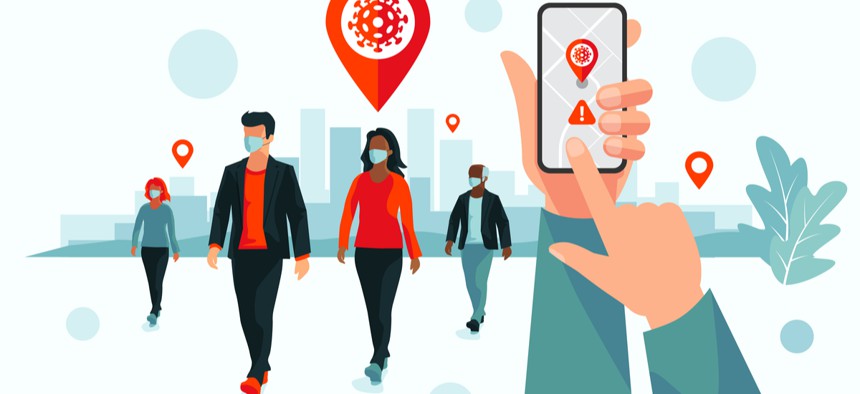DHS Launching Voluntary COVID-19 Contact Tracing Program

Redkey USB/Shutterstock
Employees will be able to self-report a positive diagnosis through the ServiceNow help desk and official contact tracers will follow up with anyone who might have been exposed.
The Homeland Security Department is beginning to “reconstitute” its workforce back in the office after a year of mass teleworking and is standing up a voluntary contact tracing program to stem potential interoffice spread of COVID-19.
Federal employees across government have been working from home for close to a year after the Trump administration in March 2020 ordered agencies to provide “maximum telework flexibilities” to employees as COVID-19 infections reached pandemic proportions. As Americans get vaccinated, in-person work can resume, but DHS officials want to ensure their offices don’t become breeding grounds for another outbreak.
“As DHS plans to reconstitute the workforce, it is essential to have an internal DHS Contact Tracing Program that protects the workforce and our families by preventing further spread of COVID-19,” according to a data collection notice published Wednesday in the Federal Register. “If DHS does not establish an internal COVID-19 Contact Tracing program capable of quickly identifying, isolating, tracking, and being aware of potential office outbreaks and workforce exposures, COVID-19 can unknowingly spread throughout the DHS workspace and negatively impact mission readiness and national security.”
DHS officials did not immediately response to Nextgov’s questions on reopening procedures or the percentage of employees currently teleworking.
The department published a similar notice on Jan. 15 but didn’t receive any comments during the 30-day window. The same information was republished Wednesday to allow for an additional 30-day comment period.
The program will be voluntary, as the department will not be testing employees but rather requests that they self-report a positive COVID-19 diagnosis to their supervisor. For the purposes of the contract tracing program, “the term employee is used to include federal employee, contractor, detailee, volunteer and intern,” according to the document.
Once an employee alters their supervisor to their status, the manager will contact the DHS Supervisory Contact Tracer with the employee’s name and contact information.
“The Supervisory Contact tracer will assign a Contact Tracer to contact and interview the COVID-19 positive employee and obtain a list of employees the COVID-19 positive employee was in close contact with, as well as locations in the DHS worksite that the COVID-19 positive employee visited for 15 minutes or more,” the document states.
Employees self-reporting a positive COVID-19 result will be asked for the following information:
- First and last name.
- COVID-19 lab test result.
- Name of DHS component office.
- Office address.
- Personal phone number.
- Work phone number and email.
- Primary work site, e.g., department, floor, field desk location.
- Supervisor’s name, phone number and email.
- All activities, floors visited in the DHS work site, meetings attended—including lunches, etc.—that the COVID-19 positive employee participated in starting 48 hours before their first symptoms.
- Late date worked at a DHS work site.
- First and last names of federal employees, contractors, detailees, interns, volunteers who the COVID-19 positive employee was in close contact with, along with the close contacts’ work email addresses, work phone numbers, and the last dates of contact.
That information will be collected and processed through the department’s ServiceNow application, which DHS uses for its IT help desk.
“ServiceNow will be modified to be used as the COVID-19 reporting tool,” the document states. “The COVID-19 positive employee or their supervisor will create a new ticket in the COVID-19 reporting tool and include locations in the office that they were in for 15 minutes or more—to initiate facility cleaning—and names of employees they were in close contact with for 15 minutes or more—to identify exposed individuals to notify. The COVID-19 reporting tool will create a ticket and route this to the employee’s supervisor and the supervisory contract tracer.”
From there, the ticket will be assigned to a contact tracer who will call the COVID-positive employee to confirm the information submitted through the app, then contact potentially exposed employees so they can take the next steps.
Potentially exposed employees will be told to notify “their supervisor, contracting company (contractors only), medical provider, and local public health authorities to get instructions,” but will not be given any information about the COVID-positive employee, such as their name.
The contact tracer will also have to follow a set script outlining the process and the employees’ privacy rights.
The notice also states that no information collected through the program will be shared with third parties outside of “the DHS component or office who employs the individual about whom the information will be collected,” their supervisor and the assigned contact tracer.
In a survey of 688 federal employees conducted last year by the Government Business Council, the research arm of Nextgov parent company Government Executive Media Group, many respondents said their agency was tracking infections among employees. The survey asked federal employees whether their agency had a contact tracing program, whether that program used an app and the likelihood they would participate in voluntary programs.






